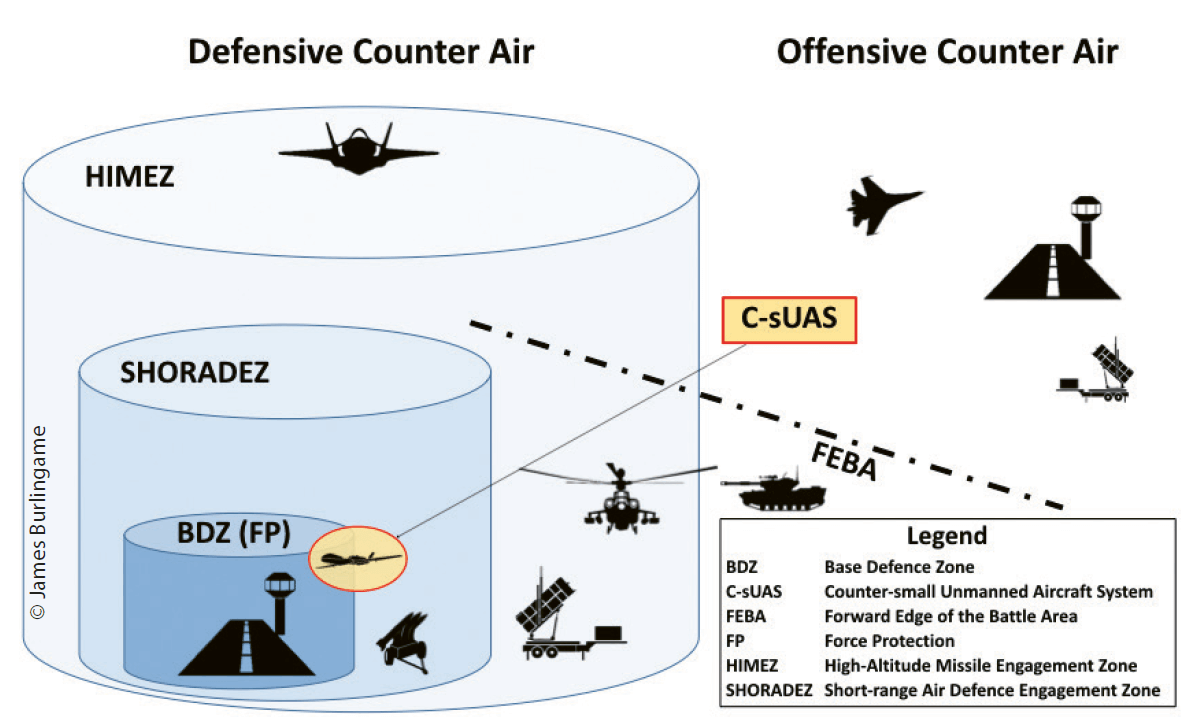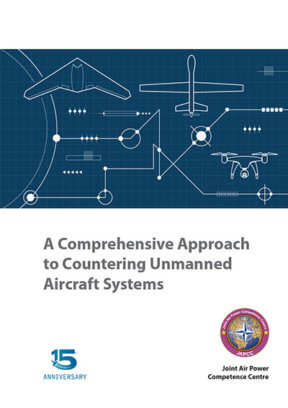Introduction
Education and Training (E&T) is an integral part of any armed forces’ ability to generate, maintain and strengthen their military capabilities, provide security and practise collective defence in the broader context of the NATO Alliance. With today’s swift innovations in technology and their incorporation into military forces, non-state armed groups, and terrorist organizations, E&T requires constant review and adaptation. This holds especially true for unmanned systems, due to their increased civilian and recreational use and the subsequent complications for military activities, even before actual conflict.
NATO has defined four core dimensions to this adjustment process: education programmes, individual training, collective training, and exercises.1 With an emphasis on the tactical level, this chapter focuses on the first two dimensions as prerequisites to any further collective training and exercises on the operational level and higher. It discusses how Unmanned Aircraft Systems (UAS) and drones present new challenges to NATO forces and thus require enhancing individual knowledge and skills to defend against them.
How Unmanned Aircraft Systems and Drones Change(d) Warfare
Proliferation of Unmanned Aircraft Systems and Drones
The last two decades have seen the evolution of military unmanned capabilities, predominantly in the air domain. The success of UAS operations in the global war against terrorism, as well as the use of drones by the terrorists themselves, created an unprecedented demand for those systems on both sides. At least 95 countries currently possess UAS or run their own development programmes.2 At the same time, the commercial market has been flooded with drones for a variety of recreational and commercial applications. Chapter 3 (cf. p. 34 ff.) outlines the proliferation of UAS and drones in more detail.
Due to this widespread proliferation of UAS and commercially available drones, and based on numerous examples of recent conflicts, it should be expected that the probability of these systems being used against NATO forces is exceptionally high. This likelihood, in turn, requires a thorough analysis of these systems’ capabilities, the potential new threats they present, and how forces need to be educated and trained to cope with this challenge.
New Capabilities, Potential Threats, and Challenges
For decades, if not centuries, the military has been the driving factor for the development of new technologies and state of the art equipment, which has almost exclusively been reserved for military purposes. This situation changed drastically after drones be-came a product for wide recreational and commercial use.
Sensors. Chapter 3 (cf. p. 41 f.) provides an overview of the typical sensor suites currently available for military and commercial systems, such as Electro-Optical/Infrared (EO/IR), Synthetic Aperture Radar (SAR), Light Detection and Ranging (LiDAR), or Multi-/Hyper-Spectral Sensors. Most of these sensors are not new, but due to the commercialization of drone applications, these sensors are no longer exclusively reserved for military use and are no longer a niche capability. Sensor resolution has been significantly increased over the last 5-10 years, while Size, Weight and Power (SWaP) requirements have been drastically reduced. These improvements enable even small drones to carry sophisticated sensor equipment, something that was not considered feasible just a few years ago. Hence, NATO has to expect that every UAS and drone is likely capable of capturing high-definition imagery and video, to include recognizing thermal signatures. More dedicated sensors such as LiDAR can even map terrain and objects through clouds and beneath forest canopies or detect disturbed soil from, for example, tracked vehicle movements.
Weapons. Depending on their size, many UAS are capable of carrying the same air-to-ground and in some cases air-to-air munitions as their manned counterparts. It is noteworthy that Russian, Chinese and to some extent Iranian systems are almost always armed, independent of their actual primary mission. Chapter 3 (cf. p. 36 ff.) and Annex B (cf. p. 513 ff.) provide an overview of these systems. Commercially available drones, although generally unarmed, can be converted into an airborne Improvised Explosive Devices (IEDs). Even a payload of explosives as little as a couple of hundred grams can have devastating destructive potential if aimed properly. Moreover, UAS and drones report their sensor data back to their attached network or operator which can then be used to generate coordinates for targeting or indirect fires. Hence, even small drones require serious attention if spotted in the vicinity of friendly forces or infrastructure.
Employment. UAS and drones offer the unique advantage to employ a surveillance and strike capability at relatively low cost and with reduced risk of friendly casualties. Consumer drones, due to their almost negligible cost, may be intended for one-time use only and not recovered. Additionally, Low, Slow, and Small (LSS) drones operate at altitudes insufficiently covered by traditional air surveillance radars. LSS drones also offer little to no relevant signatures for current air defence systems to be employed successfully, notwithstanding the significant cost-benefit imbalance of high-tech anti-air munitions against the drone. These factors strongly support the employment of UAS and drones even in heavily defended air space or other situations where manned combat aircraft are at risk. Therefore, NATO has to anticipate UAS and drones to be directed against friendly forces at all stages of a conflict and independent of own air superiority.
Current Education and Training versus New Threats
The possibility that our forces may be subject to airborne ISR, air-to-ground strikes, and indirect fires is not new. However, NATO forces have neither experienced nor were required to anticipate any substantial air threat since the end of the Cold War-era. Air dominance was either a given or always achieved easily and therefore not a priority task for the majority of NATO forces. A lot of NATO nations significantly reduced their Surface-Based Air and Missile Defence (SBAMD) forces and some nations even totally dismantled their Short-Range Air Defence Systems (SHORAD), losing with them an entire generation of educated and trained personnel. However, the possibility to employ UAS and drones anytime, anywhere, and with affordable, robust capabilities implies a significant change to the potential threats NATO has to anticipate from the air.
Airborne Intelligence, Surveillance, and Reconnaissance
Protection against reconnaissance from the air has taken on a whole new dimension. UAS and especially drones are affordable in much larger numbers, and often operate at significantly lower altitudes than legacy ISR aircraft, thus bringing their modern sensors way closer to their target than was thinkable in the past. During the Cold War-era, it was assumed to be sufficient to spread camouflage nets over large areas and blur vehicle tracks in the terrain to escape enemy reconnaissance from the air, or at least to make it more difficult. However, today’s sensors can easily penetrate the forest canopy and wide meshes of traditional camouflage nets, detect IR radiation and recent changes in ground conditions.
Air-to-Ground Strikes
The leap in unmanned technology in conjunction with the refinement of Precision-Guided Munitions (PGM) merged into a strike capability that was not envisioned during the Cold War nor has it been witnessed from any adversary in NATO’s recent warfighting history. Moreover, UAS and drones can be used with kamikaze tactics by turning the vehicle itself into a weapon, homing in via their sensor inputs, such as thermal signatures, pre-programmed picture patterns, or radar and radio emissions. These threats were traditionally countered, for example, by the dispersal of forces in order to minimize the potential damage of an attack. In contrast, NATO’s recent decades of warfighting against an asymmetric enemy led to a situation in which protective measures focused mostly on a two-dimensional threat. For example, vehicles in military convoys or patrols followed each other very closely, and field camps were set up centrally and in the open to host large amounts of forces.
Direction of Indirect Fires
In the same way as NATO’s recent warfighting history was not confronted by any substantial air threat, massive artillery fires were also not of concern apart from irregular and uncoordinated mortar fire incidents. Future conflicts against a near-peer or peer adversary, however, may see a re-emergence of an indirect fires threat. Modern artillery systems can deliver massive firepower within minutes of request and UAS and drones are likely to provide the respective target information. This has already been demonstrated in Eastern Ukraine where Russian forces directed and adjusted artillery fires with even Commercial-Off-The-Shelf (COTS) drones. The new threat dimension arises from the potential increase in speed between target acquisition and delivery of fires. In addition, improved accuracy of target data and therefore fires as a whole must be expected, since both UAS as well as artillery systems now utilize space-based navigation and timing support.
How Education and Training Needs to Adapt to Countering the Unmanned Threat
First and foremost, it is imperative to recognize the C-UAS challenge and approach the problem holistically. Chapter 5 (cf. p. 75 ff.) outlines a possible comprehensive approach to C-UAS, whereas E&T plays a fundamental role for the recommended preventive and reactive countermeasures. However, it may not always be required to develop new Tactics, Techniques, and Procedures (TTP) to deal with a changing threat environment. Many long-established training concepts probably just need to be revitalised or moderately adapted to cover parts of the new unmanned threat. The following sections briefly describe the respective educational disciplines and training areas.
General Knowledge of Drone Capabilities
The first step in defending against a threat is to understand it. Education about UAS and drone capabilities should start as early as possible, preferably as part of the general basic training of new recruits or cadets. ‘Drone Defence’ should have a priority equal to other general topics, e.g. Nuclear, Biological, and Chemical (NBC) defence or All Arms Air Defence. The curriculum should at least cover the different classes and types of military UAS and commercially available drones, their sensor capabilities, as well as their potential weapons effects. For very little money, basic training units may be equipped with consumer drone models to demonstrate basic sensor capabilities first-hand.
Adapted General Rules of Conduct for the Individual Soldier
Defensive tactics against UAS and drones needs to be trained down to the lowest tactical level. There are already many traditional countermeasures against air threats in place that merely need to be adapted. The following subsections contain brief examples of possible adaptations of established tactical level TTPs. This list is far from exhaustive, and the general rules of conduct should be thoroughly reviewed concerning UAS and drone threats.
Camouflage. Command posts, combat vehicles in resting areas or hidden positions, as well as larger equipment, have always been concealed from air threats. In contrast, traditional measures of individual soldiers were usually aimed against observation from the ground only. Soldiers need to amend their camouflage tactics to also include measures against UAS and drone observations.
Thermal Screening. The standard pairing with an EO camera is an IR sensor. Thus, heat sources require additional attention when attempting to conceal them from enemy view. Older camouflage nets have a mesh size of several centimetres which cannot sufficiently shield thermal radiation. If newer generations of heat shielding nets are not yet available, makeshift measures such as covering bonnets with a thick layer of earth, may be considered.
Emission Control Measures. UAS can be equipped with Signals Intelligence (SIGINT) payloads which can be used to detect, track and locate the source of Radio Frequency (RF) transmissions, since modern Command and Control (C2) relies heavily on this type of communications. Therefore, enemy SIGINT requires thorough attention and probably reintroduction of traditional measures such as radio silence, cable communication or even forwarding messages by courier if possible. Other often overlooked sources of radio transmissions are the soldiers’ mobile phones, wireless headphones and smartwatches which can undermine all other radio silence measures.
Dispersion. A long-established and successful measure to mitigate enemy weapons effects is the dispersion of combat vehicles and soldiers. With regard to the anticipated future presence of armed UAS and drones converted into airborne IEDs, it is even more essential to stick to this principle. Current TTPs developed and refined over the last decades of asymmetric warfare probably require an update in this regard with added focus on the third dimension.
Reporting. With their sensors, UAS and drones can cover an area much larger than can be observed by an individual soldier, a team, squad or even platoon. The presence of an enemy UAS or drone can be very likely linked to an upcoming attack or other effect. Reporting procedures about these detections help alert adjacent units and support the situational awareness of higher echelons. With regards to UAS and drones, it is important to accurately identify the class and type of system, altitude, direction and observable weaponry to help prepare appropriate countermeasures.
Adapted Readiness Levels for Air Defence
Dedicated air defence systems as well as All Arms Air Defence adhere to a set of NATO wide defined readiness states which regulate the weapons control status and areas of anti-air weapons. These levels may be reviewed and amended to also incorporate rules and measures to defend against the different classes and types of UAS and drones, if not already covered. Permission to fire at unmanned systems may be granted more easily than against manned aircraft since only material damage will be inflicted.
Adapted Responsibilities and Fire Areas for Anti-Air Weapons
UAS and drones come in various sizes and operate at different altitudes and airspeeds. To avoid responsibility gaps, all anti-air weapons in NATO are typically integrated and fire areas coordinated. However, NATO’s Integrated Air and Missile Defence System (NATINAMDS) needs to adapt to the new UAS and drone threats and consider (re)integrating the Army’s organic air defence units as well as the upcoming generation of dedicated C-UAS systems. This, in turn, requires review and revision of current air defence capabilities related doctrine and TTPs.

NATO Integrated Air and Missile Defence will have to counter the UAS air threat that already is within its identified threat spectrum (e.g. HALE/MALE). Also, the total subset and amount of UAS and drones that can be handled by NATINAMDS need to be identified and integrated into current doctrine and policies. The interface to other capabilities outside of NATINAMDS needs to be specified and incorporated into these same doctrines and policies.
Short-Range Air Defence (SHORAD). Tactical UAS fly typically lower and are usually smaller than HALE or MALE systems. This lower region of defended airspace may be covered by SHORAD systems that are not part of NATINAMDS. As tactical UAS are relatively low cost, Anti-Aircraft Artillery (AAA) and Counter-Rocket, Artillery, & Mortar (C-RAM) systems could provide a cost-efficient anti-air capability against these systems.
All Arms Air Defence and Dedicated C-UAS Systems. Consumer and commercial drones fly at even lower altitudes than tactical systems, typically below 1,000 ft. They can usually only be detected by dedicated C-UAS systems and the reaction time for counter-measures is so low, that defending against these drones is mostly a self-defence duty.
Supplementary Curriculums for Aircraft Identification
LSS Drones, and also to a certain extent tactical UAS, can be expected to fly below the threshold of traditional air defence radars. This capability gap could be filled by air observers, which are supported by dedicated C-UAS equipment against LSS air threats. E&T for air observers should be reviewed and adapted to include the aforementioned threats. Specialized C-UAS equipment will likely expand the respective curriculums significantly and may necessitate the training of dedicated specialists on the unit or platoon level.
Recommendations
UAS and drones have been successfully incorporated into our countries’ military inventories, and these systems have significantly changed the way NATO conducts warfare. Due to this success, potential adversaries are keen to follow the same approach and replicate NATO’s unmanned capabilities. As a result, the Nations have to review and adapt their E&T curriculums to address the threat from UAS and drones being directed against friendly forces.
NATO Training Doctrine, Tactics, Techniques, and Procedures
Countering UAS and drones is a comprehensive challenge, and this chapter primarily discussed how education and training are affected down to the lowest tactical level. Still, the true scope of the C-UAS challenge unfolds only in conjunction with the other chapters of this book, which address the various other military disciplines involved. To address this challenge, the different NATO training doctrines and TTPs need to be identified, reviewed, and, if necessary, revised. It may be worth considering having a dedicated C-UAS doctrine as a single point of reference and to avoid spreading interrelated content over too many publications.
NATO Countering Unmanned Aircraft Systems Working Group
The NATO Countering Unmanned Aircraft System Working Group (NATO C-UAS WG) was formally established in February 2019. This working group may also opt to take responsibility for further developing C-UAS related E&T in NATO, as the review of existing policies and the development of new policies, doctrine, and TTPs is already one of its priority focus areas.
Dedicated Countering Unmanned Aircraft Systems Discipline
‘Discipline’ is a NATO-approved sphere of knowledge and skills which supports existing and evolving capabilities. The list of disciplines is developed by the NATO HQ Supreme Allied Command Transformation (SACT) to focus E&T efforts on achieving NATO operational requirements in the respective fields. NATO should make ‘Countering UAS and drones’ a dedicated discipline in order to coordinate and align the respective E&T curriculums. The department head could help liaise between all the different disciplines involved in the C-UAS challenge.













